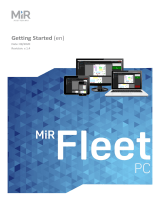
2. Safety
MiR200 User guide (en) 09/2019 - v.1.4 ©Copyright 2019: Mobile Industrial Robots A/S. 11
• Steep ramps on the route.
Risk of injury. Steep surface grades (ramps etc.) may cause the robot to skid. See Tech-
nical specifications on the website.
• Use outdoor.
Risk of injury. MiR200 is designed and intended for indoor use only.
• Overloading of the robot.
Risk of injury. If the maximum payload on top of the robot is exceeded, it may cause over-
turning, falling load. See Technical specifications on the website.
• Failure to follow the guidelines for commissioning
See Commissioning on page18.
• Failure to make a risk assessment of the full installation
See Risk assessment below. This applies to the robot with any extra modules installed.
• Operation outside the permissible operating rating parameters and environmental
specifications
Risk of instability, impact or tipping over.
• Transportation of liquids or food
Risk of instability.
• Use in potentially explosive environments
• Use in medical and life critical applications
2.5. Risk assessment
One of the most important steps in achieving a safe installation is to make a risk assessment.
The risk assessment is the responsibility of the individuals who are commissioning MiR200 in
the environment it will be used in. Most often it will be an integrator who also designs
and/or builds work cells or other required infrastructure related to MiR200.
The risk assessment must cover not only MiR200 itself, but also take into account potential
potential load transfer stations, work cells and the environment it will be used in. See
MiR100 and MiR200 Risk Analysis on the distributor page.
It is recommended that the integrator uses guidelines in ISO 12100, EN 1525, ANSI B56.5 or
other relevant standards to conduct the risk assessment.
The risk assessment shall at least consider the following scenarios:
• Detailed description of the robot installation.
• Normal operation of the robot installation.






























